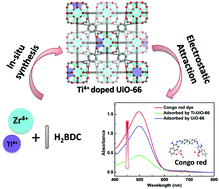In situ synthesis of titanium doped hybrid metal–organic framework UiO-66 with enhanced adsorption capacity for organic dyes†
Abstract
Titanium in different amounts has been successfully doped into the zirconium-based metal–organic framework UiO-66 via an in situ synthesis method, resulting in a series of hybrid UiO-66-nTi MOFs. These materials maintain a relatively high crystallinity and excellent structural stability. The addition of titanium has a significant effect on the crystal size and morphology of UiO-66. The UiO-66-nTi MOFs exhibit a sphere-like crystal morphology with a smaller crystal size and a rougher surface compared to the octahedral UiO-66 crystals. The framework order and porosity of the UiO-66-nTi MOFs decrease slightly due to titanium doping. The UiO-66-nTi MOFs were studied as adsorbents for the removal of an organic dye from water. The results demonstrate that these hybrid materials have enhanced adsorption capacity for the organic dye Conge red in comparison with the parent UiO-66. UiO-66-2.7Ti with 2.7% titanium doping shows the highest adsorption capacity of 979 mg g−1, which is three times higher than that of the parent UiO-66. The strong electrostatic attraction between the positively charged surface of UiO-66-2.7Ti and the negatively charged Congo red molecules was identified as the main driving force for the high adsorption capacity.



 Please wait while we load your content...
Please wait while we load your content...